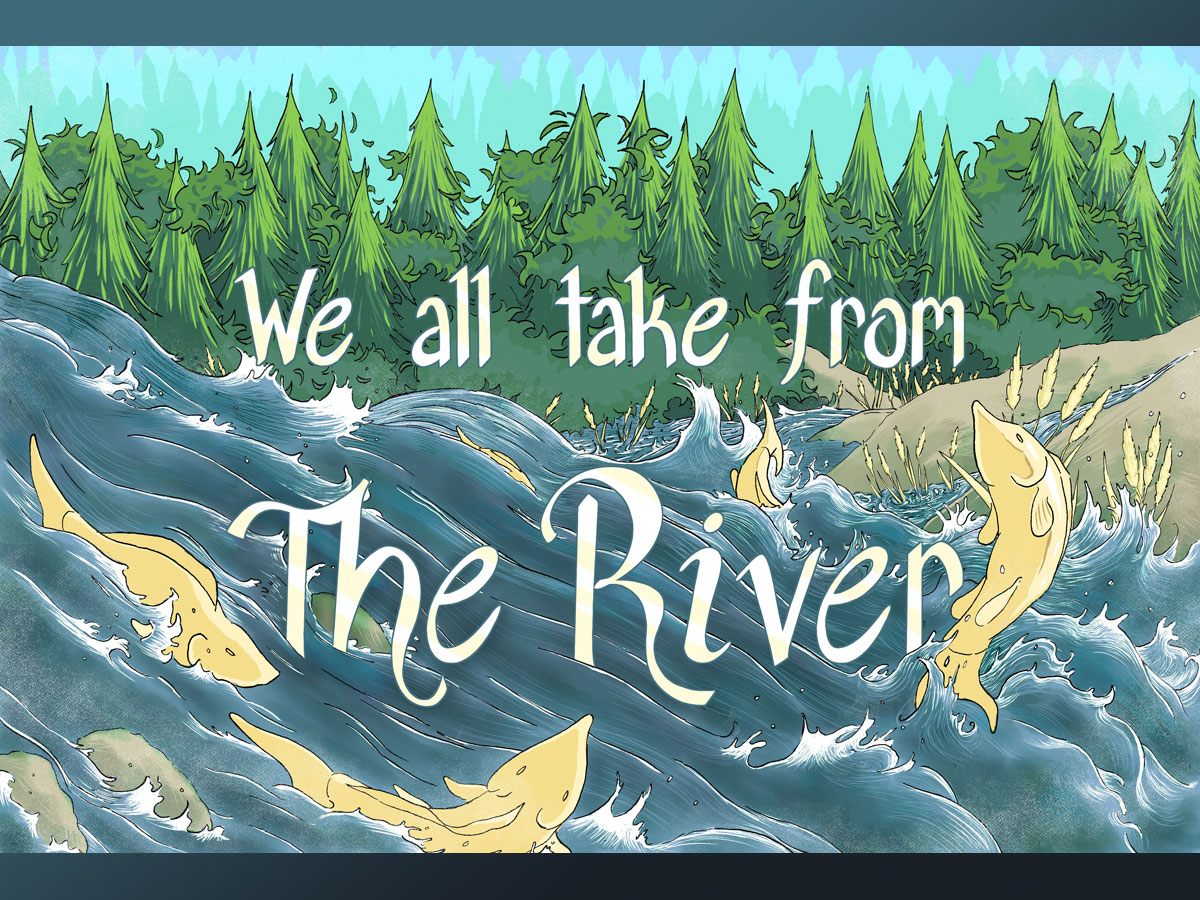We all have different visions for the river—will we bargain and compromise to achieve everyone’s goals, or will our competition destroy the ecosystem?
What Is We All Take from the River?
We All Take from the River is a resource management game for 1 to 5 players, ages 14 and up, and takes about 90 minutes to play. It’s currently seeking funding on Kickstarter, with a pledge level of $59 for a copy of the game. It’s billed as a game about environmental diplomacy and has some social deduction aspects to it, and it does have educational value but is not your typical “educational” game because it’s more about seeing consequences in action than being told a lot of facts. There is a bit of a learning curve so I think I probably would recommend playing this with teens and up.
We All Take from the River was designed, illustrated, and published by Ben Hammer.
New to Kickstarter? Check out our crowdfunding primer.

We All Take from the River Components
Note: My review is based on a prototype copy, so it is subject to change and may not reflect final component quality. The components are fairly close to what will be in the finished game, though I used my own dice for the photos so the finished dice will be something else.
Here’s what comes in the box:
- Game board
- City tile
- 8 Flood tiles
- 50 Wooden sticks
- 284 Resource tokens (Pollution, Wood, Gravel, Gold, Fish)
- Weather die (d6)
- Water Level die (d12)
- 12 Weather cards
- 10 Role cards
- 5 sets of player components, each containing:
- Camp
- 5 Net tokens
- 5 Lumber Mills
- 5 Farms
- 5 Excavators
- 5 Boats

The weather cards are standard-sized cards; the majority range from “Sun -1” to “Rain +1,” but there are a few more extreme cards like a “Drought -6,” “Torrent +6,” and the “Storm +4” shown above that pushes water back up the river in reverse for that round.
The illustrations in the game have a nice pen-and-ink style that sets it apart from a lot of board games. They almost look like something you’d see in a science textbook, which feels fitting for a game where the environment—both our effects on it and its effects on us—is central to the gameplay. I also like the illustrations on the larger role cards (you’ll see those later) and the way they’re named to correspond to the different goals.

The components are mostly pretty standard stuff, with lots of round cardboard tokens, and various wooden structures for the players. Given the theme of the game, it’s also appropriate that the components are made with materials approved by the Forest Stewardship Council.
How to Play We All Take from the River
You can download a draft of the rulebook here, and you can also try it for free on Tabletop Simulator.
The Goal
Each player has two objectives (shown on a role card). To win, you must accomplish both of your objectives, and it is possible for multiple players to win and share victory. If the river gets too polluted, all players will lose.
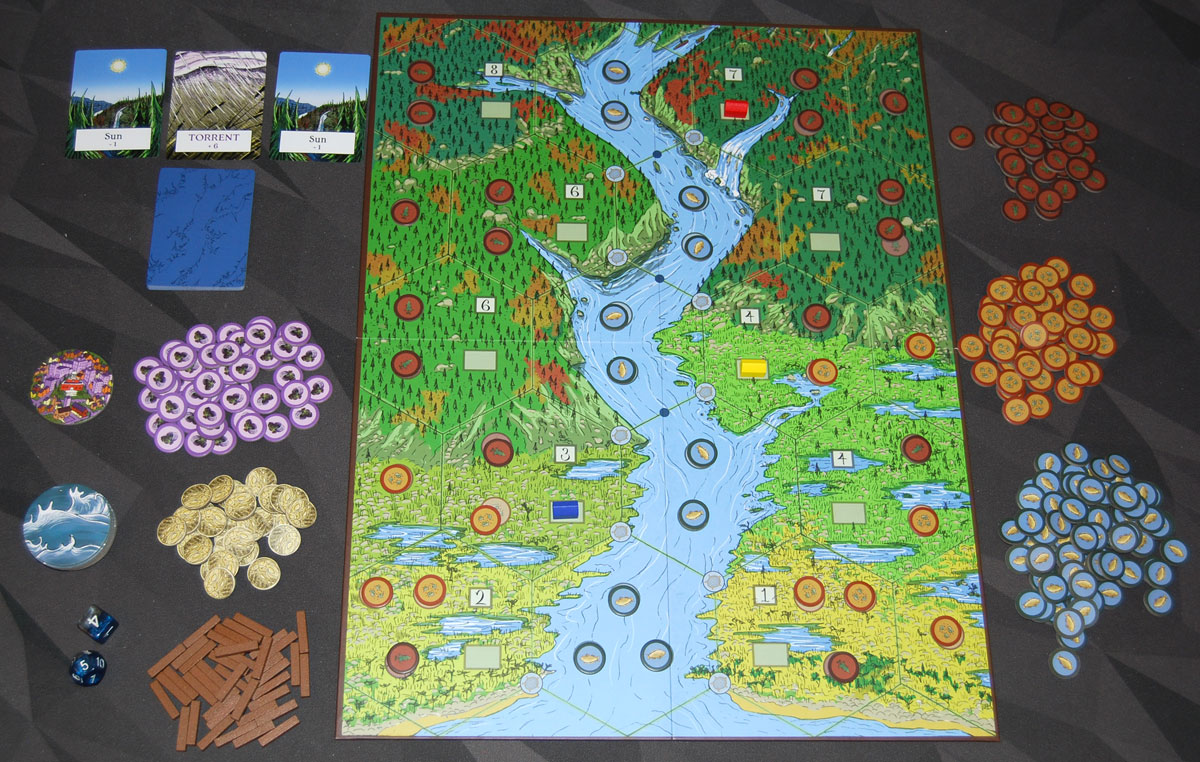
Setup
Set up the board by filling all of the resource spaces with the indicated resources: trees, fish, and gravel. Shuffle the weather cards and reveal the top 3 cards to form the almanac, showing the current day’s weather and the upcoming forecast. Give each player a set of player components, as well as 1 wood, 1 gravel, and 1 fish. Place the remaining resources and wooden sticks in a supply near the board, along with the tiles and dice.

Shuffle the role cards and deal 1 to each player. These are to be kept secret from other players.
The player who has picked up the most litter today goes first, and play goes clockwise. In turn order, each player places their camp on the board, in an empty rectangle space near the river.
Gameplay
The game will last 10 “days” with a possible 11th day if there is a storm on the last day. Each day, you roll the weather die and add or subtract the weather card to determine the starting water level, which is then tracked by the 12-sided water level die. (It’s possible for the water level to be negative, in which case use the 6-sided die to represent negative values.)
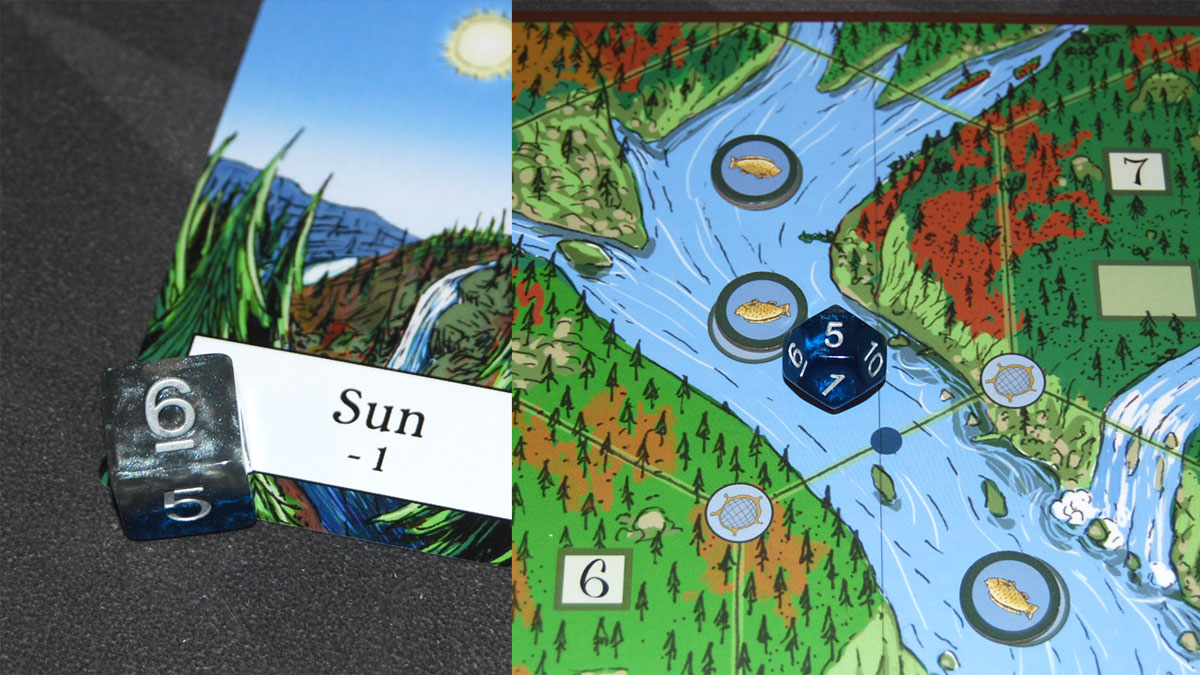
The water level die starts at the top row of the board; for each row, you will adjust the water level and check for erosion or flooding, populate natural resources, and then players in that row will take actions. Then the water level die flows downstream to the next row, and the process repeats.
The number printed in a hex is the elevation: if the water level is below the elevation, the land isn’t affected and the water level stays the same. If the water level is higher, it will erode, which can cause a number of different effects. First, if the terrain is a wetland (it has a gravel resource space), then the water level drops by 1 and you add 1 gravel if the space is empty. Then, if the water is still higher and there are trees in the space, it erodes one tree (putting it into the river) and drops by 1 again. If there weren’t any trees to erode, then it will flood instead: place the flood token on that space and push all of the pollution and gravel from that space into the river. After a flood, the structures on that tile cannot do anything that day except move.
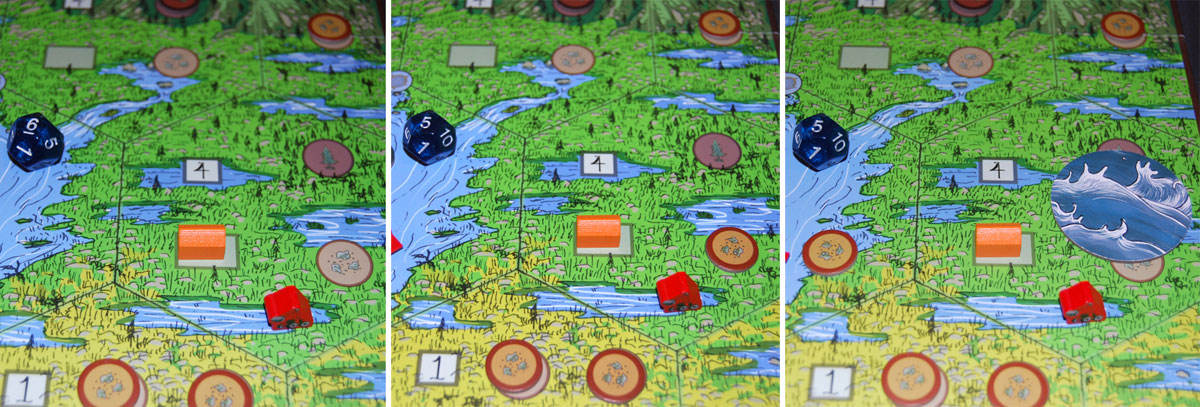
If the water level is at least 1, you will populate: First, if there’s at least 1 fish in the current row in the river, add 1 fish to the river. Then, for each hex in the row that did not flood or erode, add 1 tree in an empty space, if any. (The half-hexes on the sides of the board do not flood or erode; they will gain trees during the populate phase, or gravel when the adjacent hexes gain gravel, depending on the resource space.)
Now the players who have structures in that row get to take their actions, starting with the player on the higher elevation.
Most structures may harvest once: camps can harvest from their own location or 1 fish from the adjacent river; lumber mills and excavators harvest 2 wood or gravel, respectively, and can reach up to one tile away, but they also add 1 pollution to the river. Boats can harvest a resource from the river, or they can dredge to harvest gravel but that causes pollution. Any of these may harvest 1 pollution from their current tile instead of the other resources, or use their harvest action to plant 1 resource from your supply to a corresponding space.

Some structures are able to build. In order to build, you first pay 1 fish, and then that structure may build any number of structures in that space by paying the corresponding resource costs. Player structures may share the same location except for camps. Camps can build anything, and excavators can build canals (but they cause pollution when they do). Newly built structures do not take any actions this day, though structures with passive effects (nets and bridges) can be used as soon as they’re built.
Finally, you can move, though once you move a structure it cannot take any more actions that day (lay it on its side to indicate this). Camps and excavators may move 1 land space (camps skip over other players’ camps), and boats may move to any river tile. Your boat may also ferry a camp or excavator, using the movement for both the boat and the ferried structure.

After everyone in the row has had a chance to take actions, the water moves downstream: move the die to the next river hex, and add 1 if it passes a blue dot (every row except the last one). Any resources in the river that are not in a slot flow downstream to the next river hex. Pollution in the river will then flow into a land hex if there are any empty resource spaces adjacent to the river, starting with the higher elevation. When pollution is in a slot, it will not populate with the natural resource. Check for erosion as before and then the players in that row get a turn.
Repeat for all of the rows. In the last row, if there is pollution still in the river that did not get moved to a land tile, it displaces one of the fish slots and fills that in.
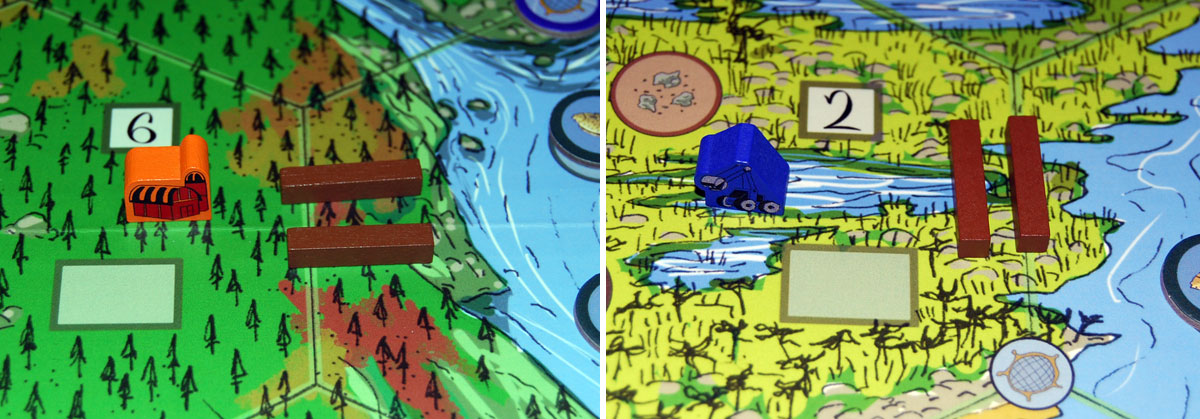
The rest of the structures have passive effects:
- Nets will collect 1 random resource that passes them as the river flows (more on that below).
- Farms gain fish after erosion and before populating the tiles: 1 fish, plus 1 fish per canal on its tile.
- Levees increase the elevation level when checking for erosion and flooding.
- Canals lower the water level after erosion/flooding but before population.
- Bridges allow land structures to move across the river.
There can be any number of levees and canals on a single tile, and the wooden sticks are used for the last three structures: place a stick parallel to the river for a levee (like a wall), perpendicular to the river for a canal, and across the middle of the river for a bridge.

End of Day
At the end of the round, any resources in the river that have not been picked up (or caught by nets) get washed to sea and are put back into the supply. If the three fish slots at the bottom of the river are filled with pollution, then the river ecosystem has been destroyed and everyone loses.
Remove flood tokens and stand up any structures that are lying down.
Now, players have an opportunity to sell resources and enact policies. For every 2 resources you return to the supply, you get 1 gold.
Then, players have the chance to propose policies. It costs 1 gold to propose a policy, and then everyone gets 1 vote (starting from the highest elevation camp to the lowest). Then, any players may spend gold for more votes, 1 gold per vote, until everyone has decided to stop. The policy passes only if there are more votes for it than against; on a tie, the policy fails.
There are three policies: a pollution subsidy, protected lands, and the city site.
If a pollution subsidy is in place, players may include pollution as resources to be exchanged for gold; otherwise, pollution cannot be traded for gold. If a pollution subsidy is in effect, you may also propose a policy to revoke it.
You may propose to protect any hex (land or river): if passed, place a gold on the hex as a reminder. In a protected land, players may not harvest anything except pollution. Protected land policies may also be revoked.

The final policy is picking a city site. If passed, place the city site on a land hex, covering up any resource slots (and removing any resources in it). At the end of the day, any players may contribute to building the city by placing the corresponding resources on it. Once there are 5 of each resource, the city is completed and the token is flipped over to show the completed city.
When the city is complete, players may buy resources at the end of the day for 1 gold each. The city produces 1 pollution on its turn each day, or 3 pollution if it is flooded. Note that if it is built over a gravel slot, the hex no longer counts as wetlands for erosion, and there are also no tree slots to protect it from floods. The city site and city may not be removed once approved.
Game End
The game ends after 10 days; the exception is that if the storm happens on the last day, you will play one more day after that. (The storm pushes the water up from the mouth of the river and all turns are in reverse order for that turn, and then the ending water level is added to the start level for the next day.)
If you achieve both of your objectives on your role card, you win! It is possible for multiple players to share victory.
Solo and 2-Player Variants
You can play solo or 2-player cooperative; in that case, you don’t use the role cards and instead, everyone is a “Settler” with three objectives: Conservation (no pollution), Agriculture (stockpile 15 fish), and Development (build the city).
Why You Should Play We All Take from the River
I first came across We All Take from the River in an Instagram ad, and the description reminded me of a book I’d read recently, A Half-Built Garden by Ruthanna Emrys. I wrote about it back in December, and it’s one of my favorite reads of 2023. Although the board game is not about first contact with aliens, both the book and the game share a lot of the same themes about climate change and diplomacy. In the book, communities are built around watersheds, and there is careful monitoring of the status of the environment, and policies are proposed and enacted through a type of consensus, with the understanding that people may have different goals but must work together to maintain this shared resource.
The story has really been on my mind since I read it, so when I saw this “game of environmental diplomacy,” I was immediately intrigued: how would you present this in a game? I contacted Ben Hammer, who sent me a prototype copy to try for myself.
I’ve gotten to play the game several times so far, and I’m really loving it. It’s not perfect—the water level and erosion mechanic can be a bit confusing until you get used to it—but it’s an effective model for the way that various people want different things from the river, with sometimes overlapping and sometimes contradictory goals. Nobody wants the river to get so polluted that the ecosystem fails, but it’s also easy to think that it’s not your problem if getting rid of pollution isn’t your objective. And the policy system, where you can spend money to push the vote in your direction? That felt a little too real at times, too.
The push and pull of the river is unpredictable, even though you get a 3-day weather forecast. Some days the river runs low, and all those canals you built to protect things downstream end up draining it too much, which means there aren’t any more trees or fish. Some days it floods, and if you aren’t prepared, you lose your actions for those structures. That can feel particularly punishing when you lose a turn, but it’s important to remember that a tile that has at least 1 tree on it won’t flood. Do you spend an action planting a tree to protect against flooding, or do you take the wood that you need right now and take the risk?
Resources can feel very tight, especially at the start of the game, when all you have is a camp. You look at goals like “stockpile 15 fish” or think about the cost of building the city, and it can feel impossible. But then you build structures and they’re also able to harvest, and you realize that maybe somebody else is also going to contribute to the city, and by the mid-game, you really start to see some of your engines chugging along.

The hidden objectives can also lead to some really great last-round maneuvering. I’ve had some games with surprising endings. In one game, it really looked like we were heading for a four-way win, but then I realized that the city (my goal) was probably going to flood and I was too far away to go help build a levee for it. Two of the other players were altruists and wanted to make sure everyone got one goal, so they were glad I still had the most gold for my capitalist objective. I briefly considered spending all of my gold after the city flooded, which would then fail both objectives, which would then mean those two players also lost. (As Alfred said, “Some men just want to watch the world burn.”) In the end, I decided to leave it alone but it was a fun twist to consider.
In another game, one player was convinced that another player shared the agriculture objective with him because they both built farms and canals in the same tile, netting a bounty of fish each turn. Little did he know that the other player actually shared the capitalist objective, and on the last turn he cashed in all of his fish for gold to snatch the victory!
What I like about We All Take from the River is the way that it shows you the effects of actions and policies on the ecosystem instead of explaining it to you. A lot of the things I’ve spelled out here in my review aren’t necessarily explicitly laid out in the rulebook, like the idea that pollution prevents trees from growing or that planting trees protects you from flooding. They’re some of the things you experience as you play, and then you try to adjust your behavior the next time—and maybe you start to think about these sorts of secondary effects of your actions in the world outside of the game too.
While it’s not your typical Eurogame and has a bit of a learning curve to it, I found We All Take from the River very compelling and I think it’s worth checking out, particularly if you have an interest in ecology. For more information or to make a pledge, visit the We All Take from the River Kickstarter page!
Click here to see all our tabletop game reviews.
![]() To subscribe to GeekDad’s tabletop gaming coverage, please copy this link and add it to your RSS reader.
To subscribe to GeekDad’s tabletop gaming coverage, please copy this link and add it to your RSS reader.
Disclosure: GeekDad received a prototype of this game for review purposes.
